
The Bottom Line
Introduction, Specifications, and Pricing
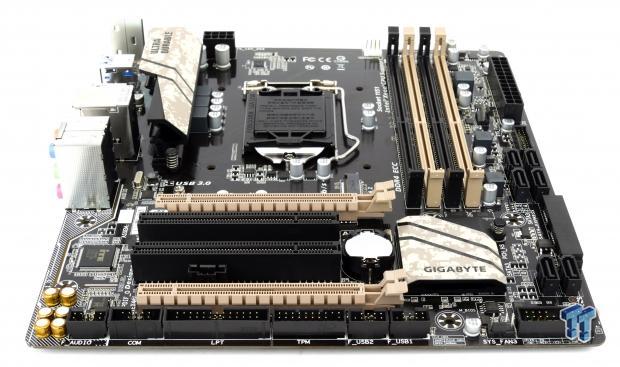
The Intel C232 chipset is a mid-range workstation-class platform controller hub aimed at business and workstation users who want to use an Intel Skylake based Xeon CPU. Along with Intel's 6th Generation Core lineup comes the Intel Xeon E3-1200 v5 family of processors, which are just Xeon variants of their Core counterparts. The benefit to using a Xeon, over the fact that they should last longer, is that they offer ECC and vPro support. These reasons make the Xeon more preferable in critical workstation and business scenarios, where memory errors cause problems and secure remote access is important.
The X150M-PRO ECC is one of GIGABYTE's C232 chipset-based motherboards. It does carry the desert camouflage theme, which shouldn't matter much, considering workstation users might not care much about aesthetics. The motherboard does bring the basic feature-set that comes with the C232 chipset and offers full Xeon and ECC memory support.
Let's take a look at this little workstation motherboard.
Specifications

The GIGABYTE X150M-Pro ECC supports E3-1200 v5 series processors, four DIMMs of ECC memory, 1Gbit Intel NIC, 2-Way CrossFireX technology, M.2, SATA Express, 6x SATA 6Gb/s, and 6x USB 3.0 ports just to name a few of the features.
Pricing
The X150M-PRO ECC is available from many large retailers for roughly $139.99.
Packaging and X150M-PRO ECC Overview
Packaging and Overview
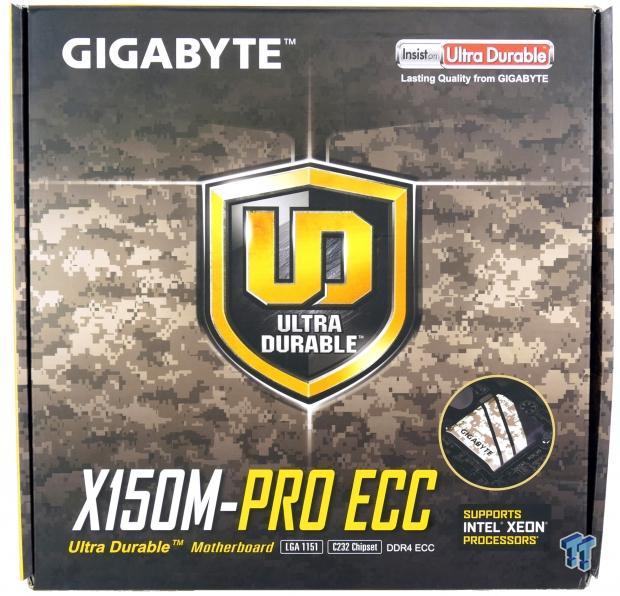

The X150M-PRO ECC's box carries the same camouflage aesthetic as the motherboard's heat sinks. If you didn't already notice, the motherboard supports ECC memory. Packaging is basic, and the motherboard comes in an anti-static bag.
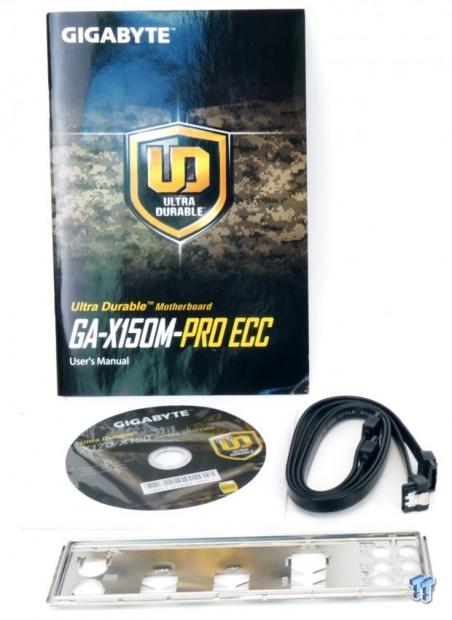
Accessories include 2x SATA6Gb/s cables, IO shield, case badge, driver DVD, and manuals.
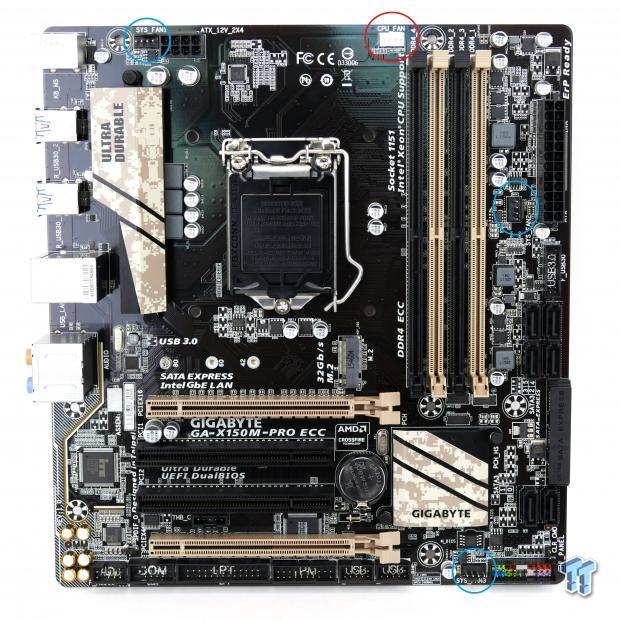
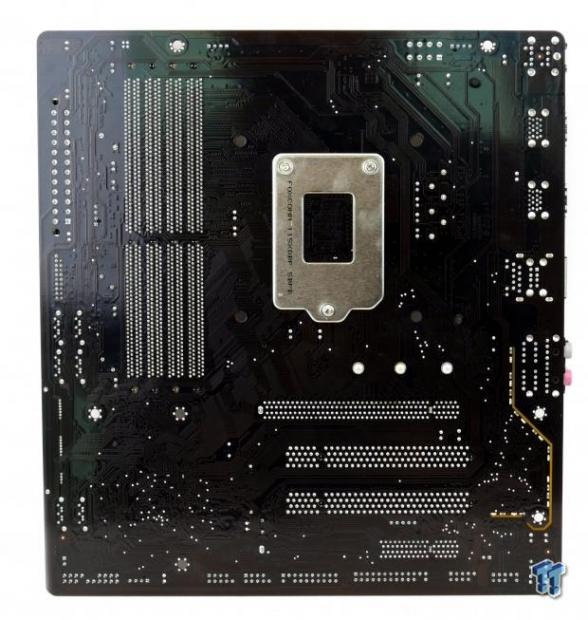
The GIGABYTE X150M-PRO ECC has four 4-pin fan headers. The one circled in red is a 4-pin PWM mode fan header, and the three circled in blue are 4-pin voltage mode headers that will control both PWM and voltage mode fans.
The motherboard has a black PCB, but it's not matte. The heat sinks are black with desert camouflage highlights. The slots are tan in color to match the heat sink highlights, and the motherboard doesn't look too bad. If you wanted a Mini-ITX camo-style build, this motherboard would fit the ticket. The back of the motherboard's PCB is very bare; there are some yellow LEDs for the audio PCB divide.

The IO panel on the X150M-PRO ECC has four USB 3.0 ports, two USB 2.0 ports, 1Gbit LAN port, PS/2 Keyboard, PS/2 Mouse, and 7.1 audio outputs.
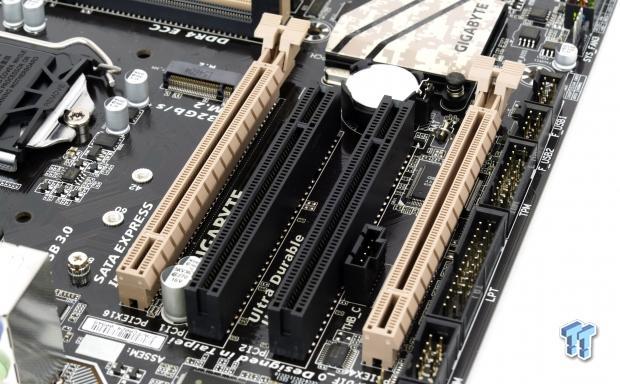
The PCI-E layout is very simple. The first x16 slot (closest to the CPU) operates at x16 PCI-E 3.0 at all times. The last x16 PCI-E slot operates at x4 PCI-E 3.0 at all times. There are two PCI slots that get their bandwidth from an ASMedia PCI-E to PCI chip.
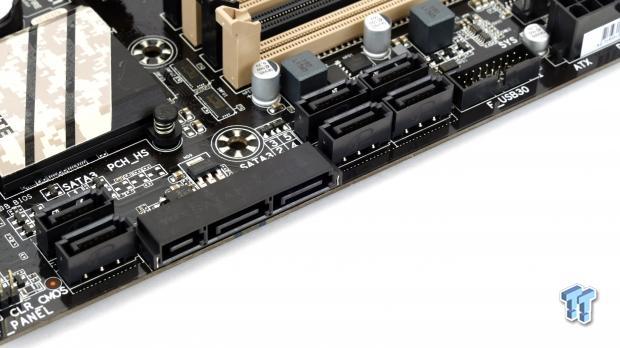
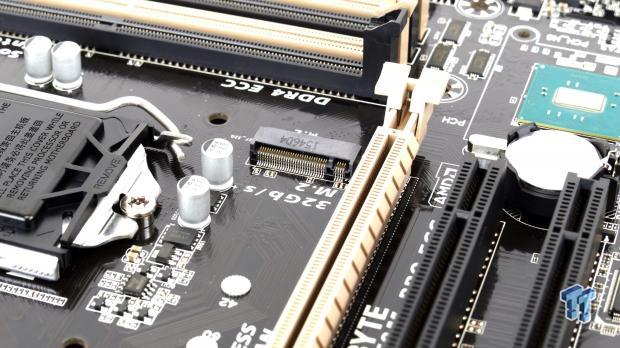
A USB 3.0 internal header is located right below the 24-pin motherboard power connector. There are six SATA6Gb/s ports that are angled straight up. The SATA Express connector can only be used with SATA Express drives, its two SATA 6Gb/s ports do not work with standard SATA drives. Surprisingly, GIGABYTE included an x4 PCI-E 3.0 M.2 slot for the fastest M.2 drives.
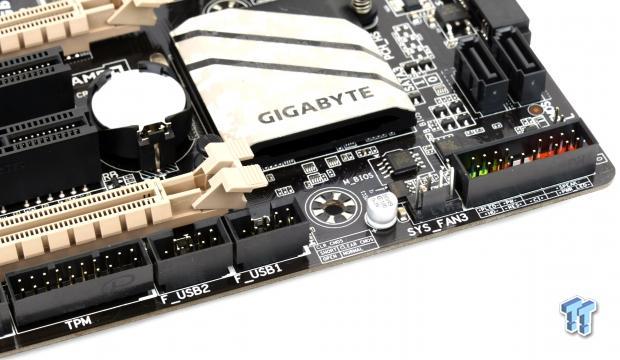
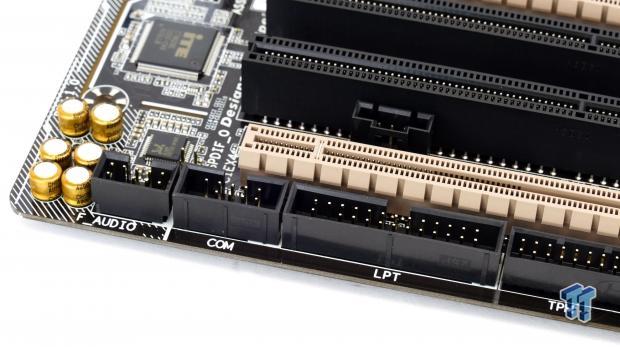
In the lower right-hand corner of the motherboard are the case headers. The motherboard also carries two USB 2.0 headers, a TPM header, LPT header, COM header, and audio header.

The heat sinks make excellent contact with the motherboard and cool the components very well.
GIGABYTE X150M-Pro ECC Circuit Analysis
Circuit Analysis
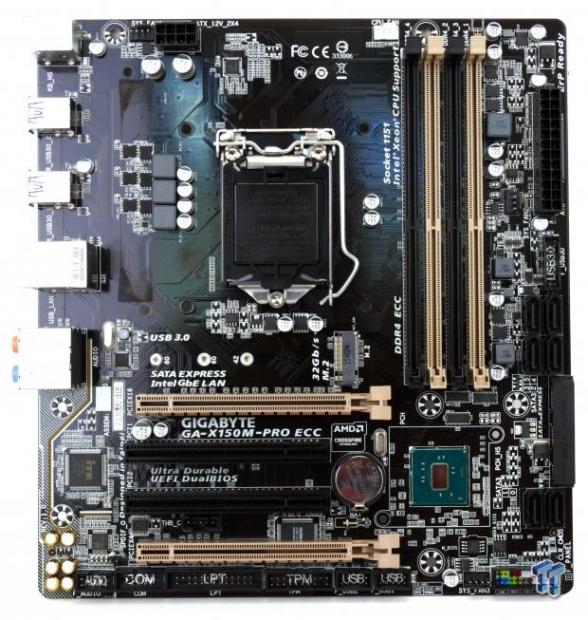
The heat sinks don't cover up much, so the board looks the same without heat sinks.
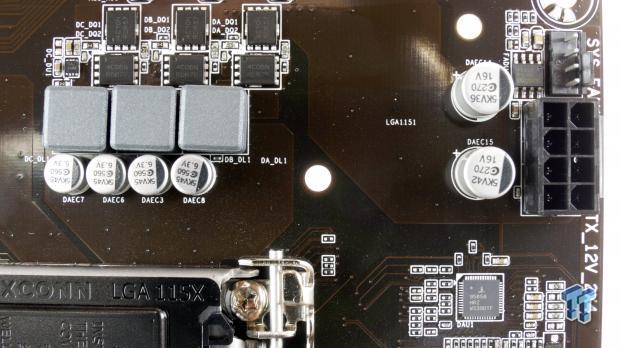
While most Z170 motherboards have two larger voltage regulators for the core and iGPU sections, many Skylake Xeons don't have integrated GPUs, and in this case integrated graphics aren't supported and so the VRM for the integrated graphics isn't present. Instead, we have a three-phase VRM for the CPU's core voltage.
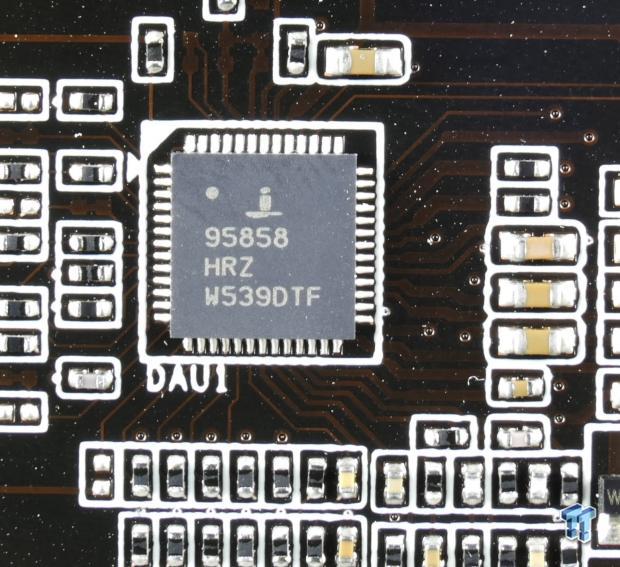
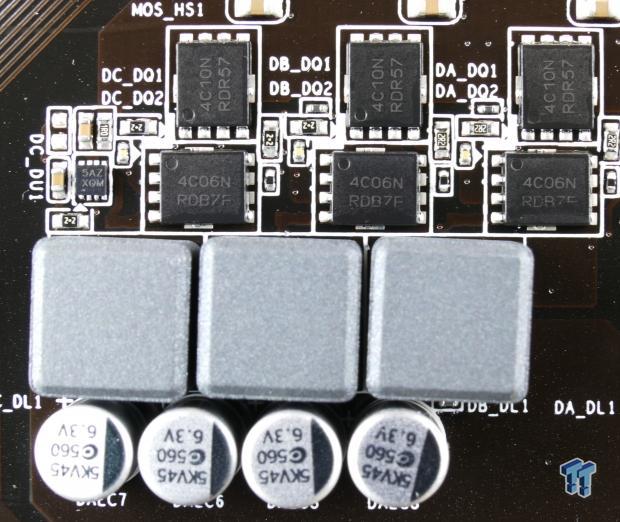
The Intersil ISL95858 is a 3+2 multiphase PWM regulator, but in this case, only the first three phases are being used. The first two of three phases have integrated drivers, while the last phase uses an external driver, the Intersil ISL6625A. Each phase is made up of an NTMFS4C06N for the low-side MOSFET and an NTMFS4C10N for the high-side MOSFET.
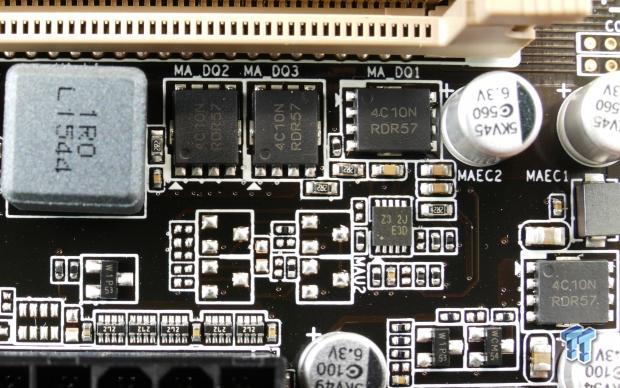
The memory VRM pictured above uses a Richtek RT8237C as the PWM controller with integrated driver and two NTMFS4C10N for the low-side and a single for the high-side.
GIGABYTE X150M-PRO ECC Circuit Analysis Continued
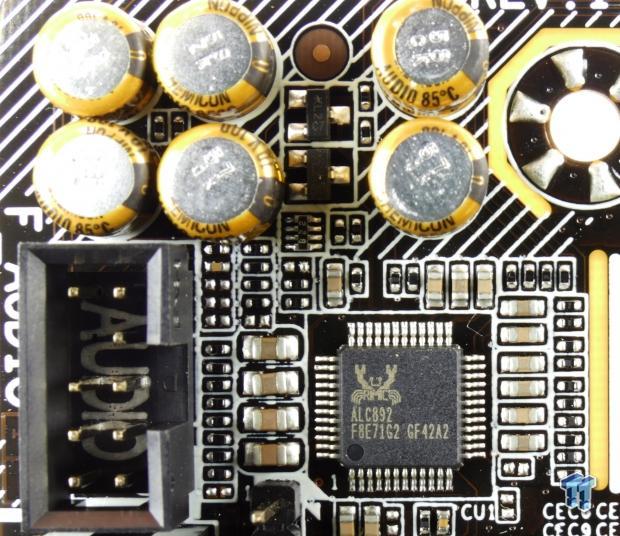
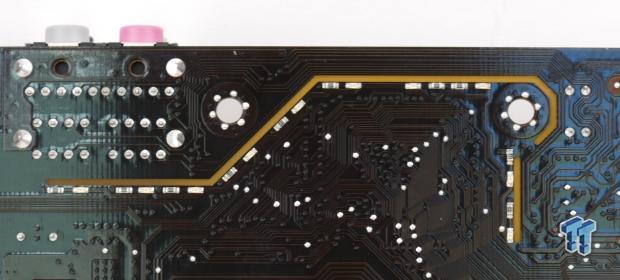
GIGABYTE is using the ALC892 audio codec along with multiple Nichicon Gold series electrolytic audio capacitors and a PCB divide. The PCB divide is illuminated by ten yellow LEDs; you can turn them off through the BIOS.
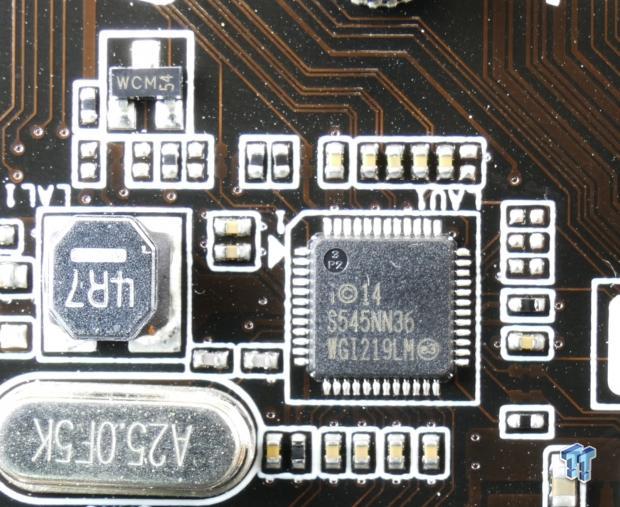
An Intel i219LM is being used for the 1Gbit Intel NIC. The "LM" version of this chip is being used instead of the "V" version since this is a workstation-class product.
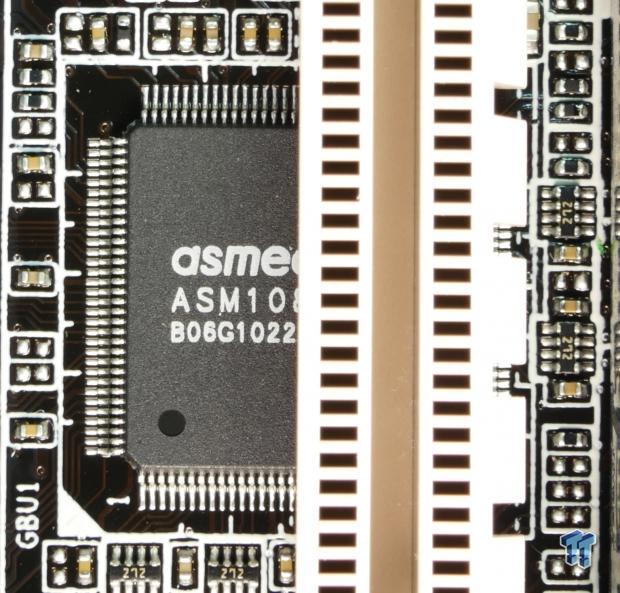
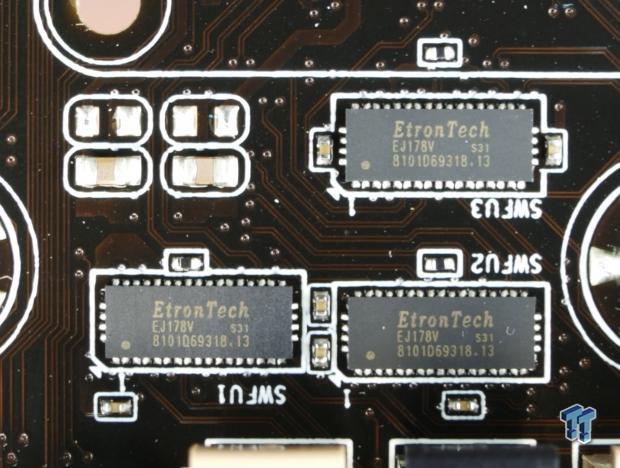
An ASMedia ASM108X series PCI-E to PCI bridge is used. It takes a single PCI-E 3.0 lane from the PCH and turns it into two PCI slots for legacy devices. Three EtronTech EJ178V are used as PCI-E 3.0 quick switches to move around High-Speed IO (HSIO) bandwidth to accommodate M.2 slot and SATA port switching.
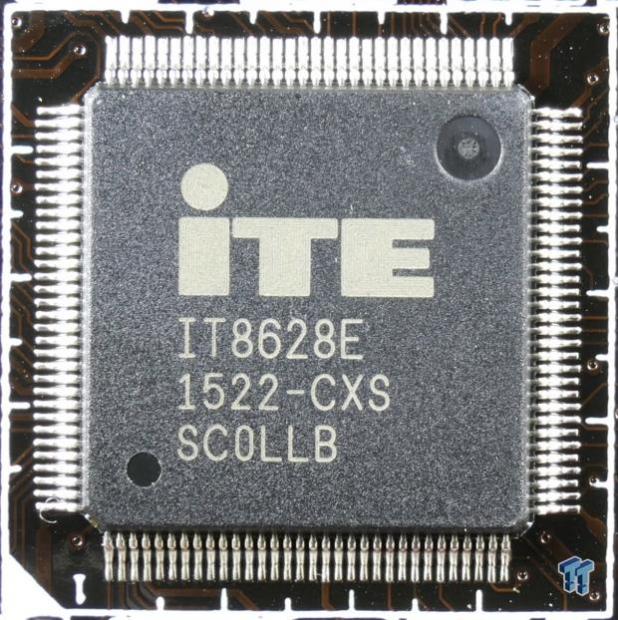
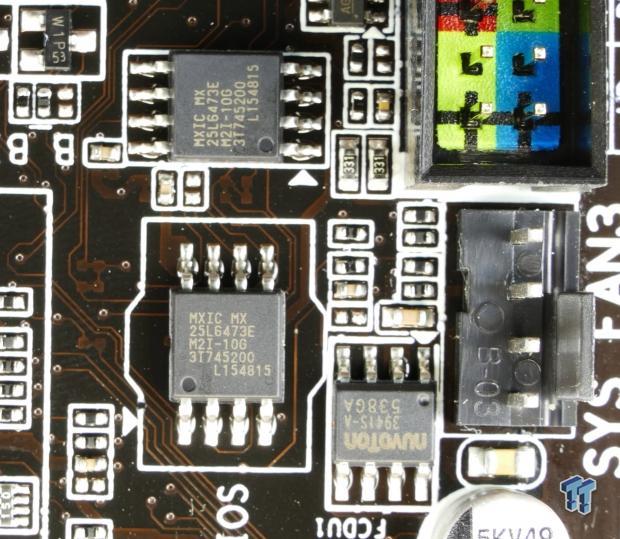
An iTE IT8628E is used as the primary SuperIO chip on the X150M-PRO ECC. Its job is to monitor the system's fan, temperature, and voltage as well as provide PS/2 on the rear IO. It also should be in charge of the COM and LPT headers. To my surprise, I found that the X150M-PRO ECC uses two 64Mbit BIOS ROMs for DualBIOS.
BIOS and Software
BIOS
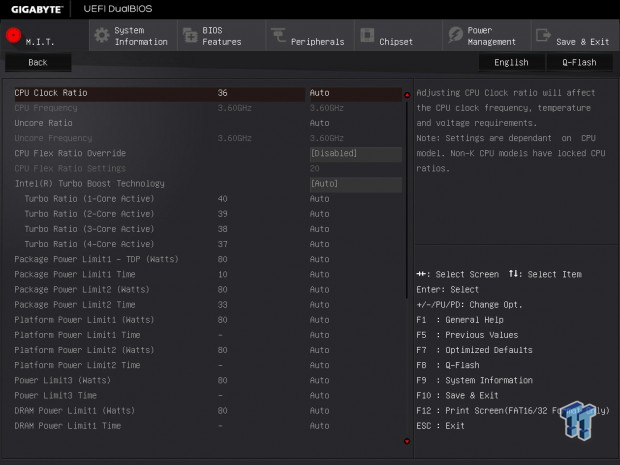
The X150M-Pro ECC features GIGABYTE's advanced mode UEFI BIOS. Customization options are minimal, and there is little to no flare, which is not a negative in this case. All the settings you might require are present to configure boot options and the different controllers on the motherboards.
Fan control is possible for most of the headers through some basic profiles (standard, full speed, silent) and a manual mode with PWM/C slopes. The only thing I didn't find was an option to enable or disable ECC memory support, I have asked GIGABYTE for a BIOS with this option.
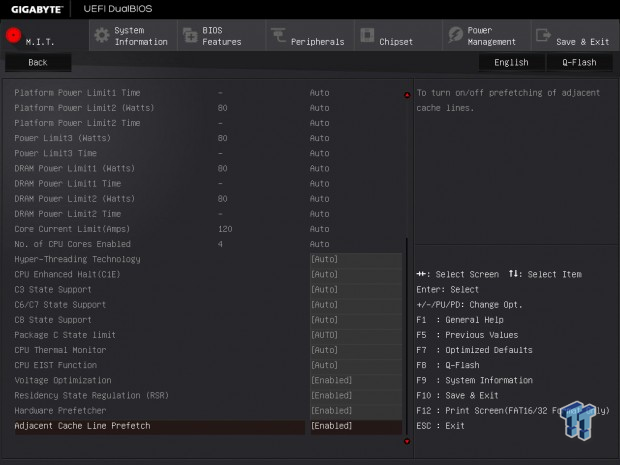
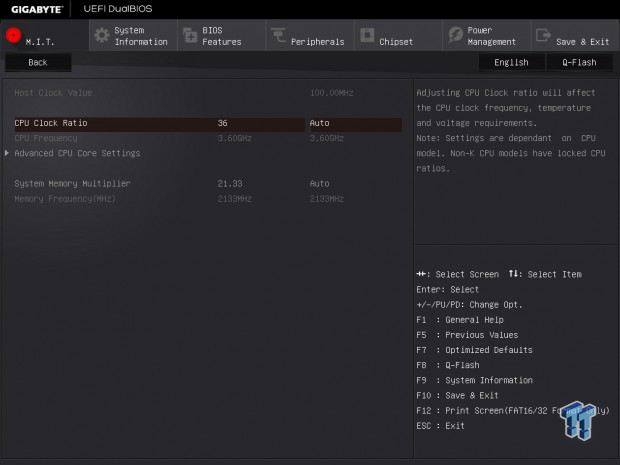
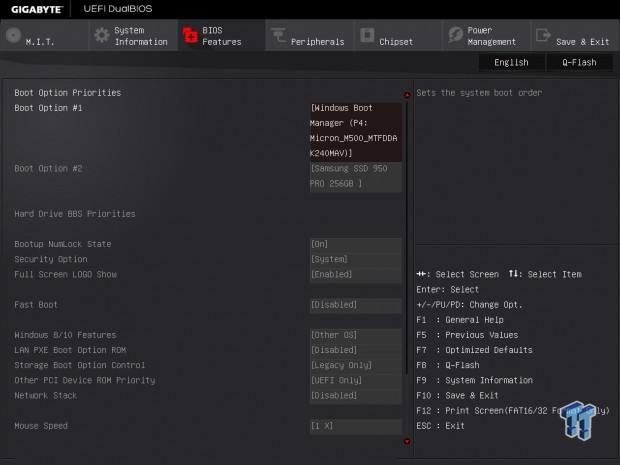
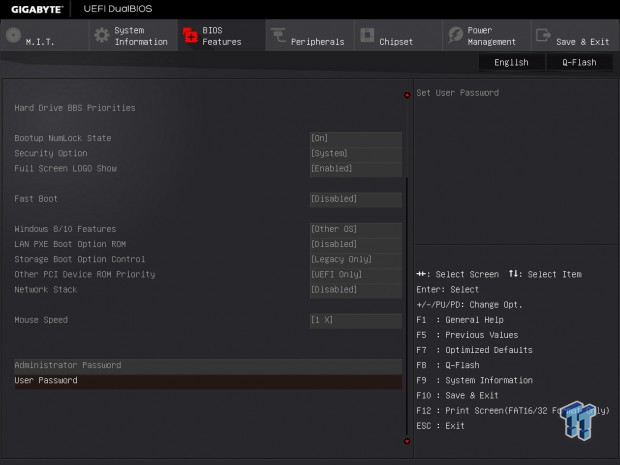
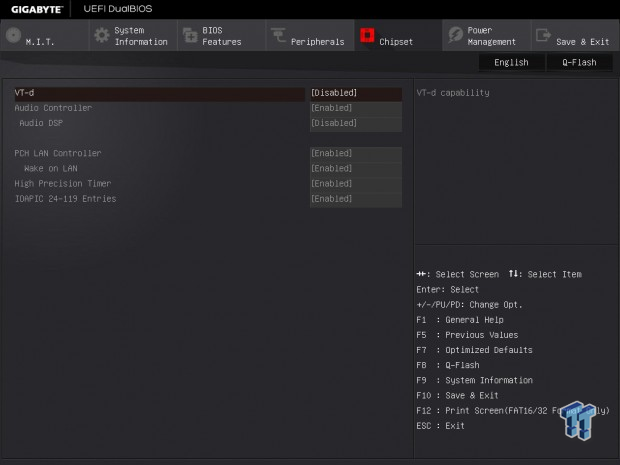
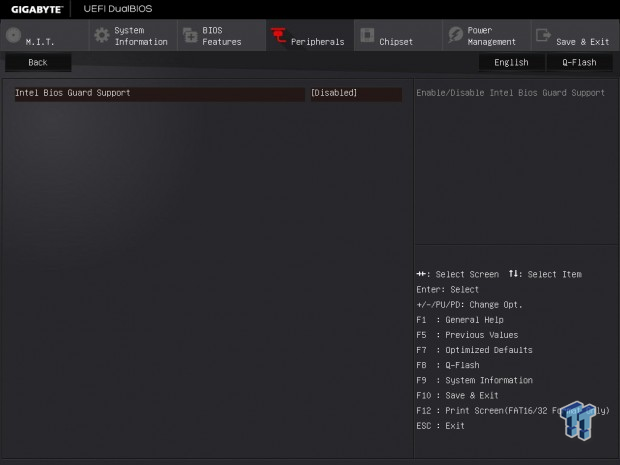
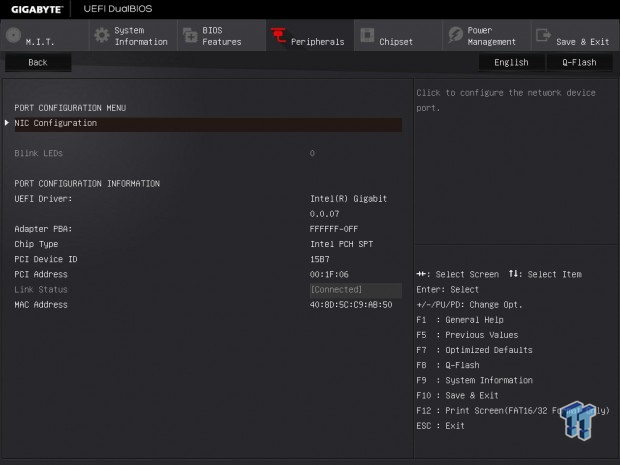
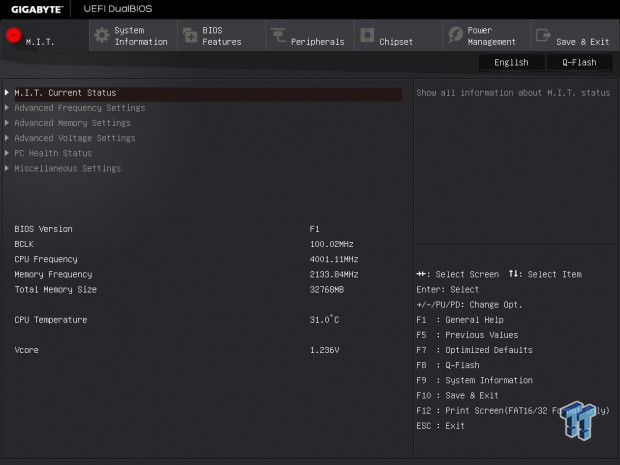
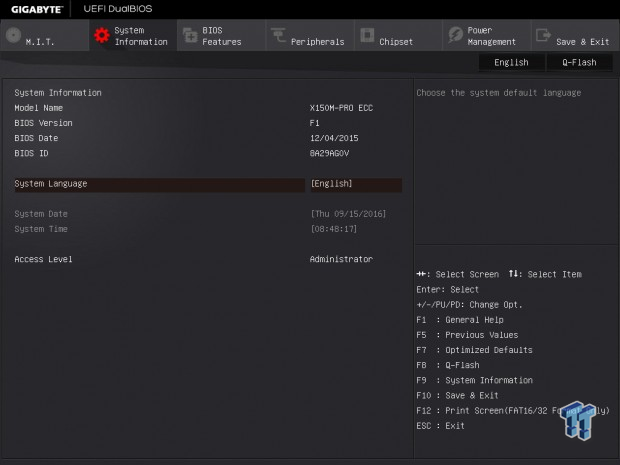
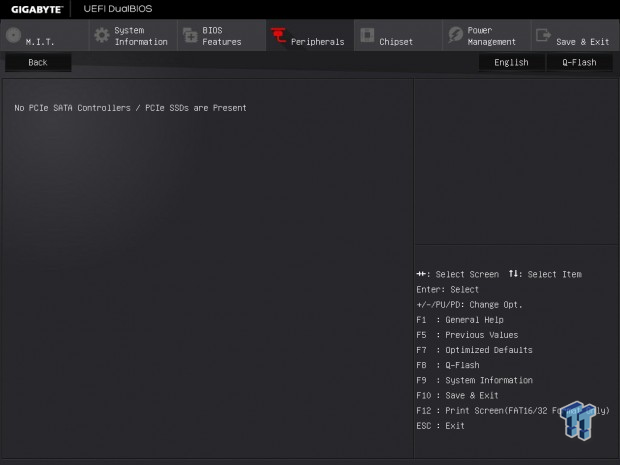
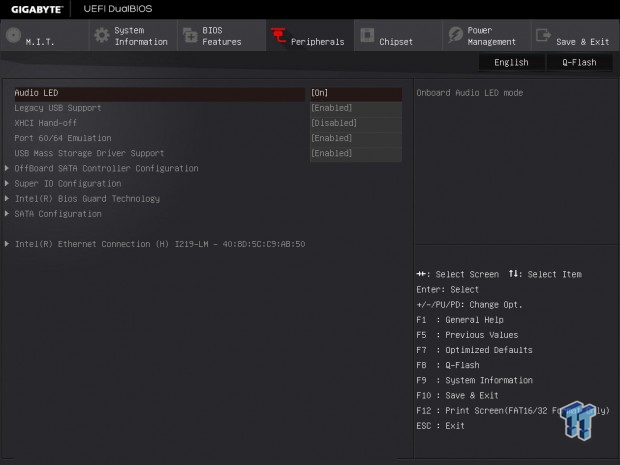
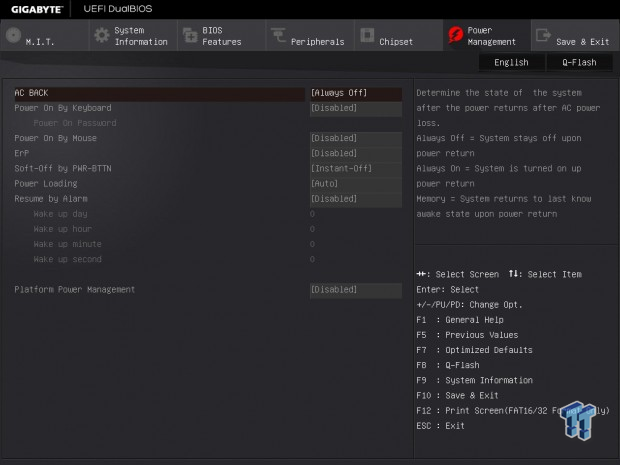
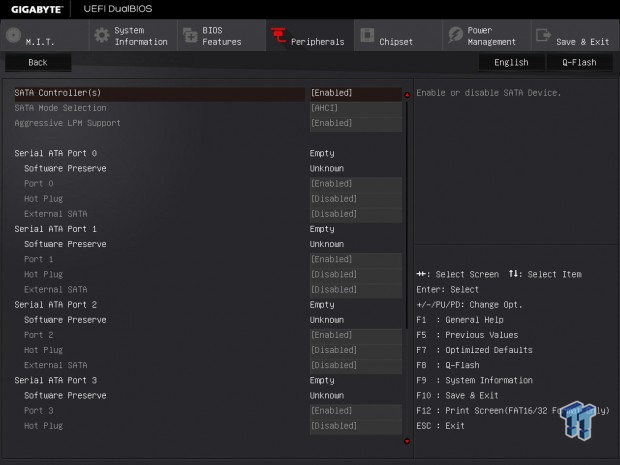
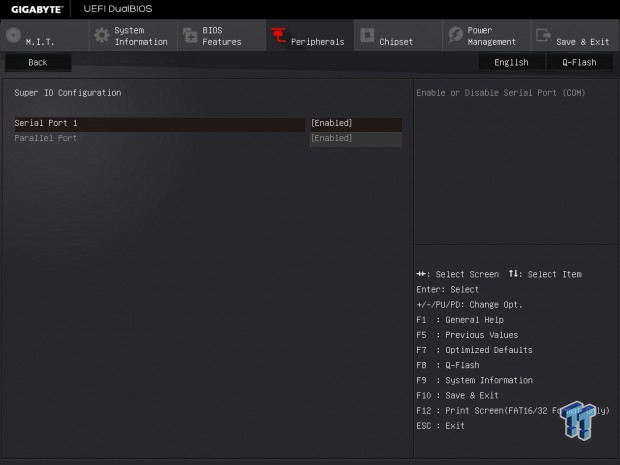
Software
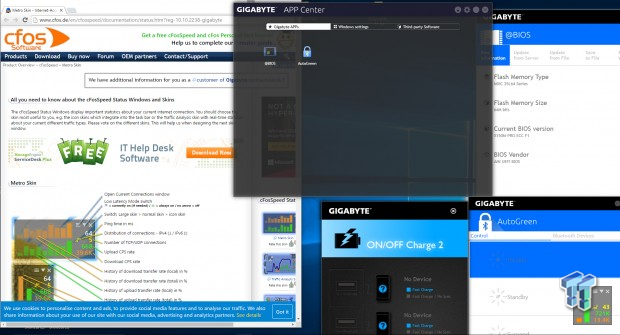
The X150M-PRO ECC doesn't support all the consumer software that you might get with one of GIGABYTE's Z170 motherboards since it is targeted towards business and workstation users.
Since the motherboard doesn't overclock, programs such as EasyTune aren't required. Nevertheless, GIGABYTE's version of cFOS network monitoring software, APP Center, AutoGreen, @BIOS, and ON/OFF Charge2 are included to name a few.
Test System Setup and ECC Memory
Steven's Motherboard Test System Specifications
- Motherboard: GIGABYTE X150M-Pro ECC
- CPU: Intel Core i7 6700K - Buy from Amazon / Read our review
- Cooler: Corsair H110i GT - Buy from Amazon
- Memory: Kingston 4x8GB KVR21E15D8/8HA - Buy from Amazon
- Video Card: NVIDIA GeForce GTX 980 - Buy from Amazon / Read our review
- Storage - Boot Drive: Samsung 850 Pro 512GB - Buy from Amazon / Read our review
- Storage - SATA6G Drive: Corsair Force LS 240GB - Buy from Amazon / Read our review
- Storage - M.2 Drive: Kingston HyperX Predator 240GB PCIe x4 - Buy from Amazon
- Storage - USB Drive: Corsair Voyager GS 64GB - Buy from Amazon / Read our review
- Case: Corsair Obsidian 900D - Buy from Amazon / Read our review
- Power Supply: Corsair AX1200i - Buy from Amazon / Read our review
- OS: Microsoft Windows 10 Pro - Buy from Amazon
- Monitor: ASUS PA328 ProArt 32" 4K
- Keyboard: Corsair K70 LUX
- Mouse: Corsair M65 PRO RGB
- Headset: Corsair VOID RGB Wireless
- BIOS: F5B
- Drivers: Intel INF: 10.1.1.9, Intel ME: 11.1.1.1162, Intel USB 3.0 Adaptation Driver: 10.0.0.42, NVIDIA Graphics: 353.82, Audio: 6.1.0.7727, Intel LAN: 20.7
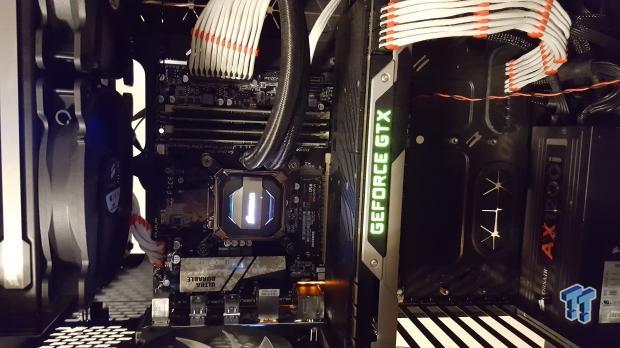
The X150M-PRO ECC is an mATX motherboard, but it can be installed in an ATX case. There are yellow LEDs that illuminate the audio PCB divide, and you can disable them through the UEFI.
The new test bench is designed to test every aspect of the motherboard and IO. I have designed it so that the motherboard sits in a case and is cooled by fans always on at a constant rate to keep the conditions similar during all tests. I have cut out part of the case behind the motherboard so I can get thermal images of the back of the PCB where the VRM heat spreads. System and CPU power measurements are now digitally logged.
I am also using a Netgear Nighthawk X4 AC2350 for our network (including wireless AC) tests. The latest M.2, SSD, and USB technologies are also being utilized to test the maximum potential of the motherboards that are tested.
ECC Memory
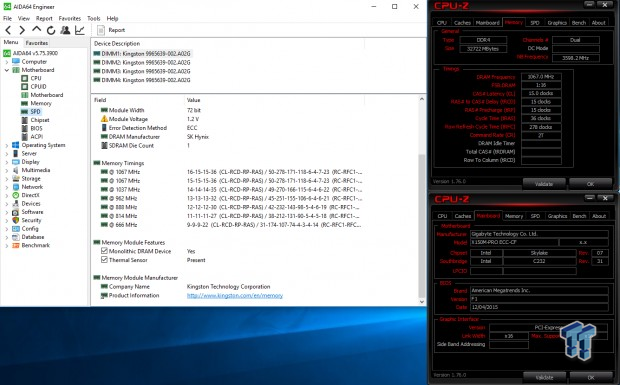

Kingston was kind enough to provide 32GB of DDR4 ECC memory. Each stick is an 8GB module, and Kingston has validated this kit with this and a few other GIGABYTE workstation-class motherboards. If you want to ensure compatibility between an Intel e3-1200 v5 series Xeon with ECC support, ECC DDR4, and GIGABYTE's X150M-PRO ECC, then this kit is a safe bet.
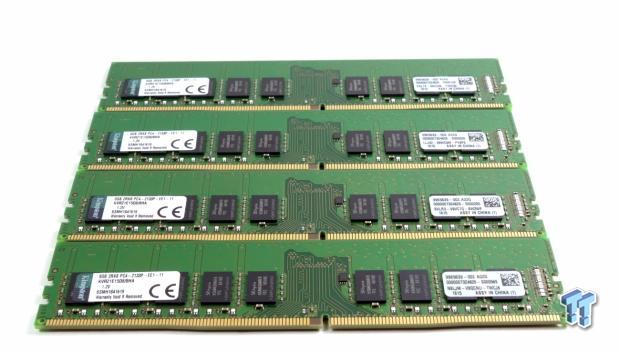
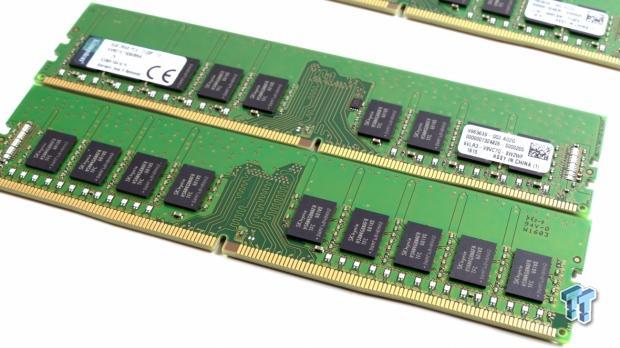
ECC memory is designed to help the system avoid errors in memory. These errors are almost unpreventable; background ration causes random bit flips within memory. At the extreme side of things, there can be five single bit errors in 8GB of RAM per hour. ECC memory uses extra memory to provide extra bits for an error-correcting mode that is executed by the chipset.
For ECC memory to work, you must use a processor compatible with ECC. In this case, we are using an Intel Xeon E3-1275 v3.
CPU, Memory, and System Benchmarks
CINEBENCH 11.5
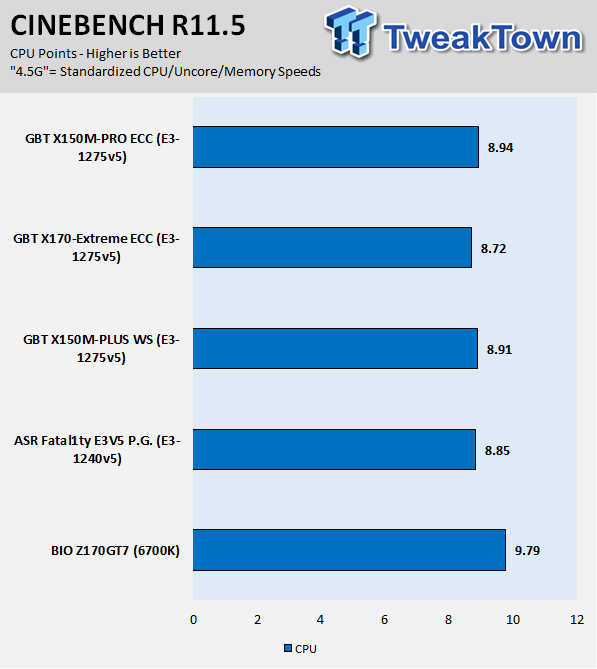
wPrime
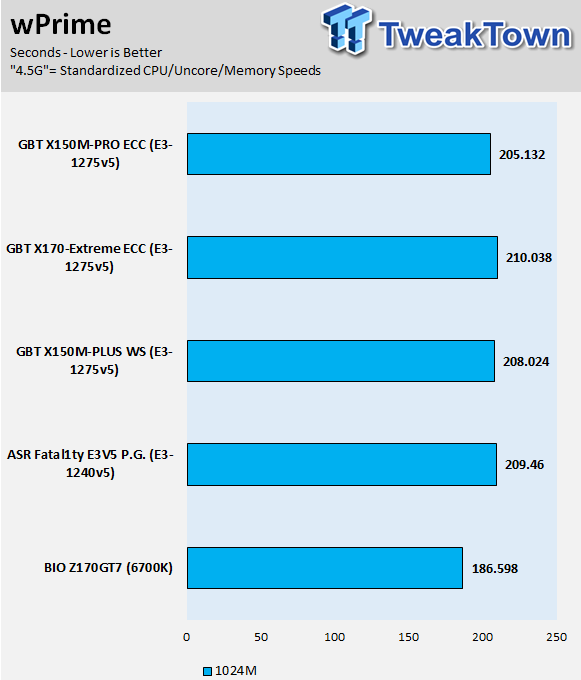
AIDA64 AES and HASH
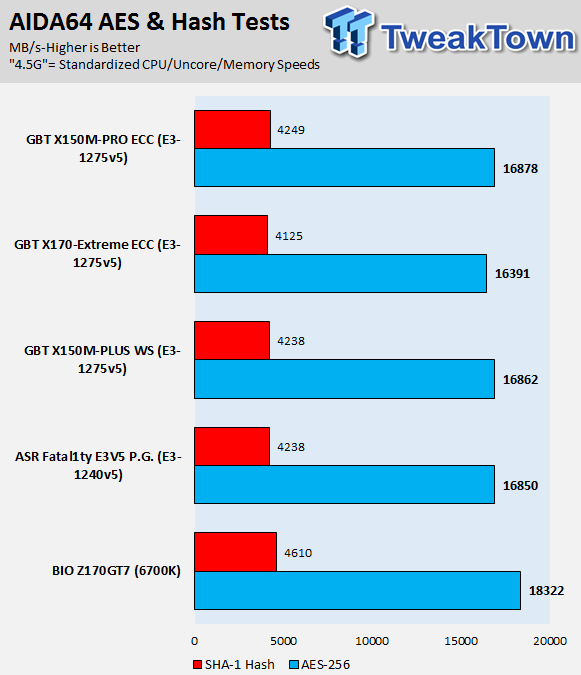
AIDA64 FPU
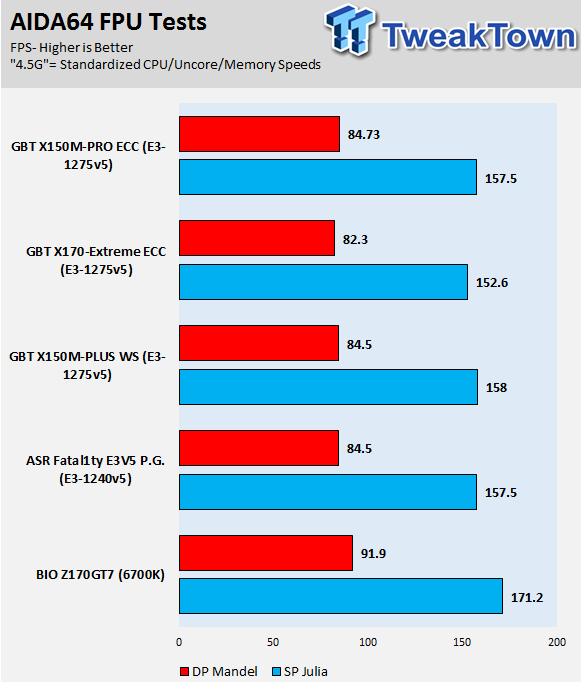
AIDA64 Memory
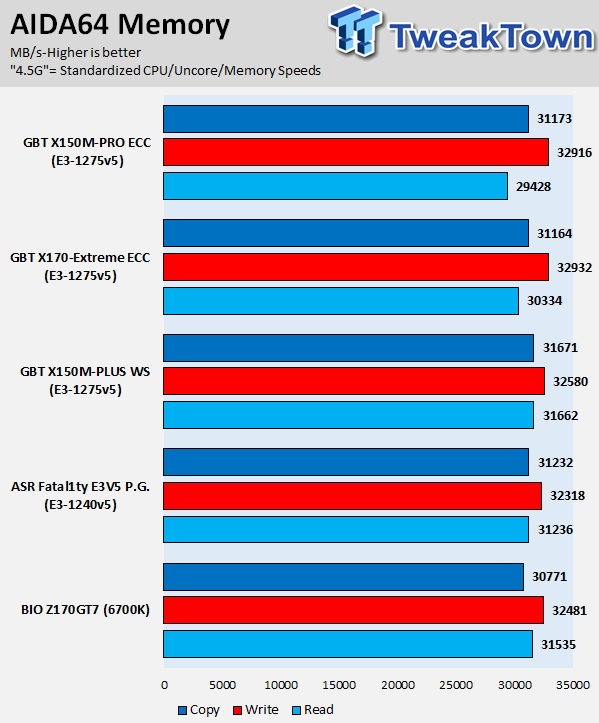
PCMark8 Home Test
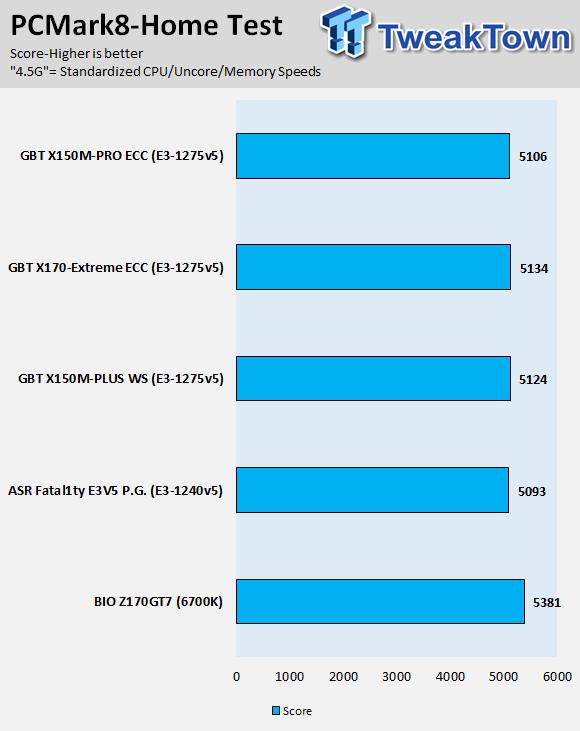
3DMark: Cloud Gate
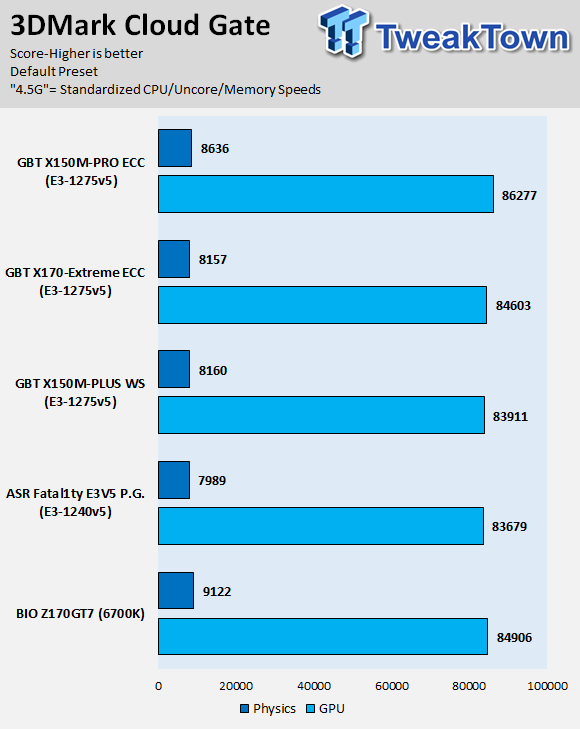
3DMark: Fire Strike
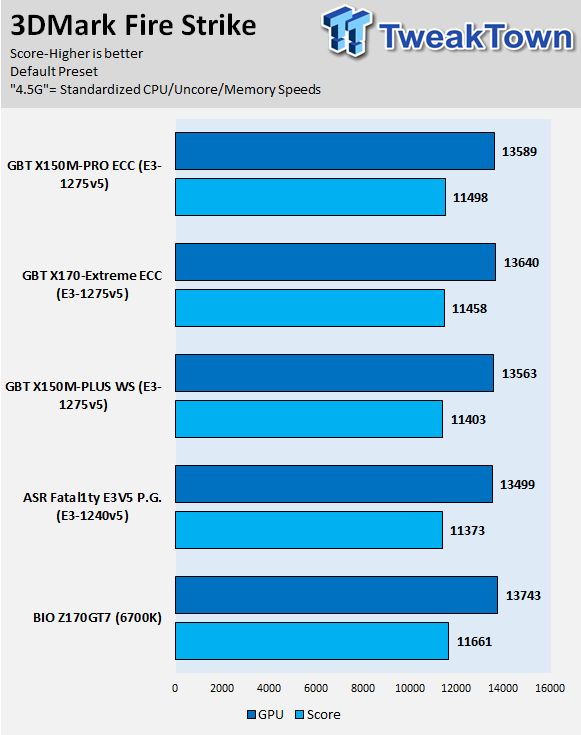
GIGABYTE's X150M-Pro ECC performs as I would expect from a basic C232 chipset motherboard when using the same Xeon I used on other C232/236 motherboards. Overall performance is strong, and there does not seem to be any areas where the motherboard bottlenecks or slows down system performance.
Some motherboard reviews put a lot of weight into motherboard CPU, memory, and GPU benchmarks, but for me, CPU, memory, and GPU benchmarks on motherboards should be more about finding anomalies, and I do that at standard settings (4.5G in graphs).
System IO Benchmarks
CrystalDiskMark SATA6G:
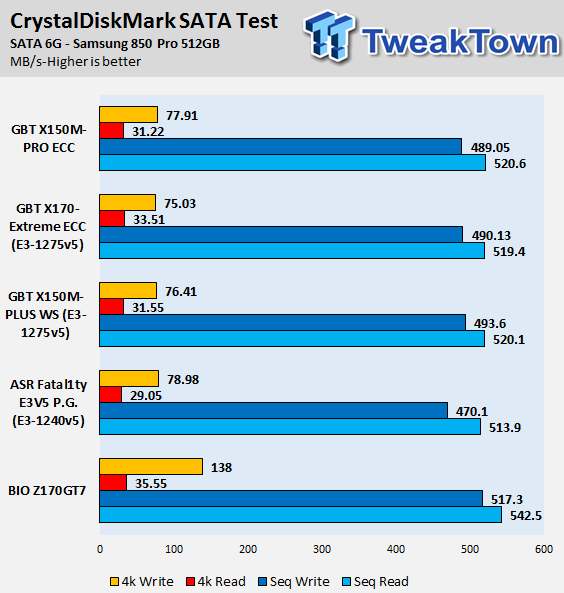
CrystalDiskMark M.2:
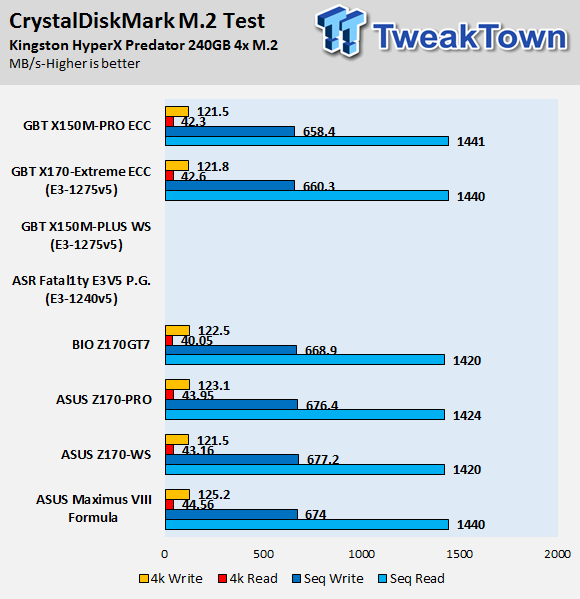
CrystalDiskMark USB 3.0:
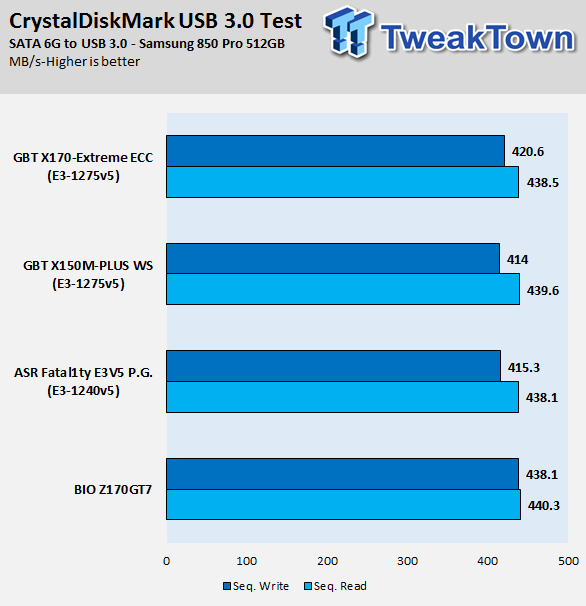
ixChariot Network Throughput:
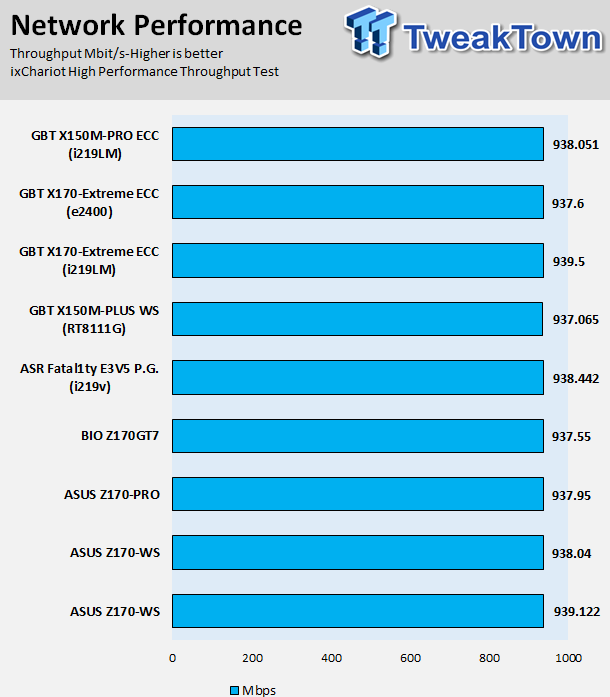
The X150M-PRO ECC performs well in SATA, M.2, and USB 3.0 tests. The M.2 slot is wired x4 PCI-E 3.0 to the PCH, so you should be okay with the latest NVMe x4 PCI-E 3.0 drives. The X150M-PRO ECC uses Intel's workstation class i219LM over the consumer i219V, and the good news is that performance doesn't take a hit.
Audio RMAA 5.5:
I disable all audio features, set the correct bitrates, and then test the audio with a loopback test.
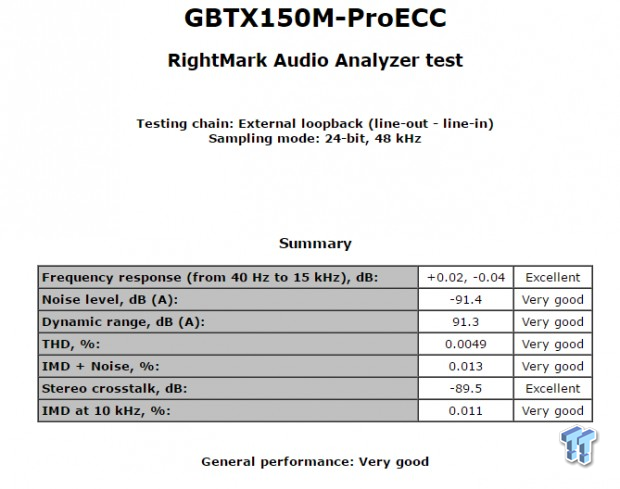
Sound Judgment by Ear: Acceptable. With its ALC892 is not the most impressive audio codec, but overall audio performance is decent for built in. There are five ratings for audio: 1. Problems, 2. Okay, 3. Acceptable, 4. Very good, 5. Excellent
Thermal Imaging and Power Consumption
System power usage is measured at the AC/DC PSU (the Corsair AX1200i) which I have connected to another system to measure the test system, and as a backup, I have a wall meter to verify. The CPU power is measured through the 8-pin connector, which is hooked up to a hall effect IC, which measures current and puts out a voltage in proportion to the current. That voltage is logged by a National Instruments ADC, which logs the DC voltage level that I then convert into current.
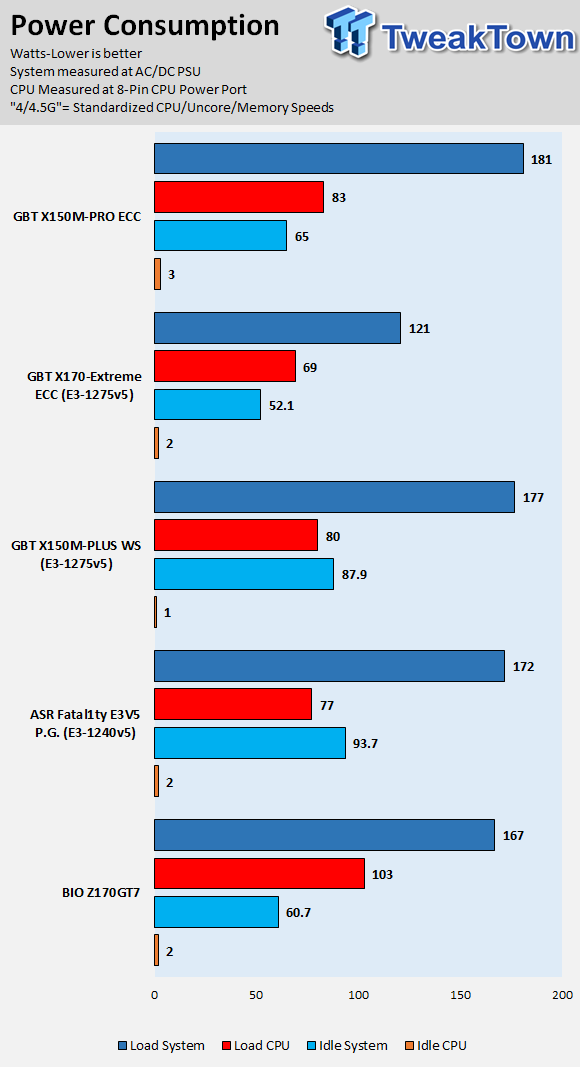
Note on Thermal Images: In the temperature section, we use our Seek thermal imaging camera to capture the surface temperatures of major components on the board. I look at the VRM and then all other things that light up the screen. If there is something to worry about, then I will state it. Otherwise, I will just show the hotter running parts of the board for fun. Unless some component is over 80-90C, then there isn't anything to worry about.
All systems will act differently, so I will look for commonalities, such as how far from the VRM the heat spreads through the PCB and the difference in temperature between the front side and backside of the PCB. Keep in mind, the majority of the heat from the VRM goes into the PCB as it is a giant soldered on copper heat sink. A larger difference in temperature between the back and front of the PCB points towards a more effective heat sink.
Thermal Testing at Stock Speeds:
The image on the left is always at idle, and the image on the right is at load. During ALL TESTS, fans above the VRM that cool the CPU cooler's (Corsair H110i GT) radiator are turned on to high (12v).


Full frontal.
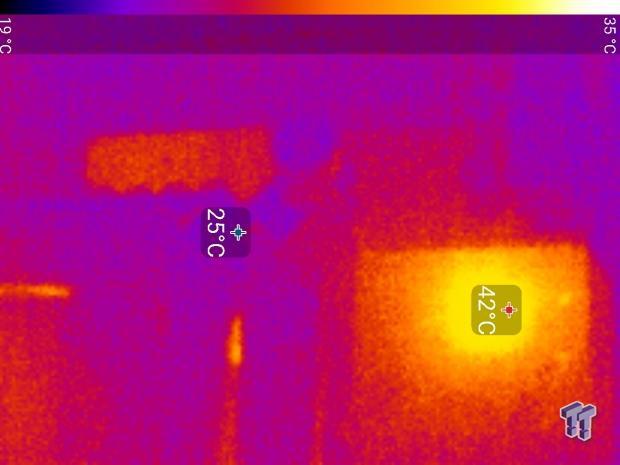
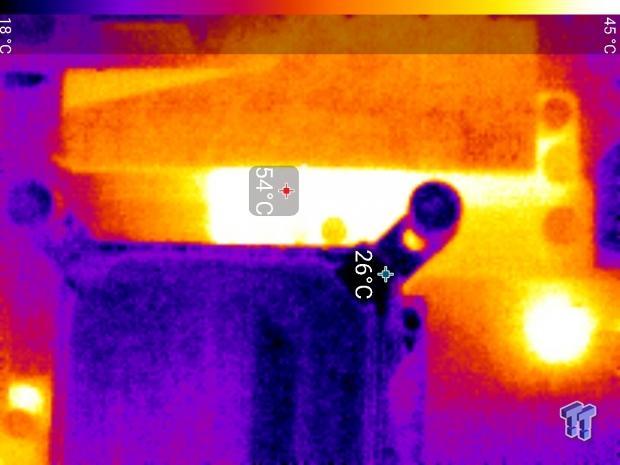
Up-close of the front of the VRM.
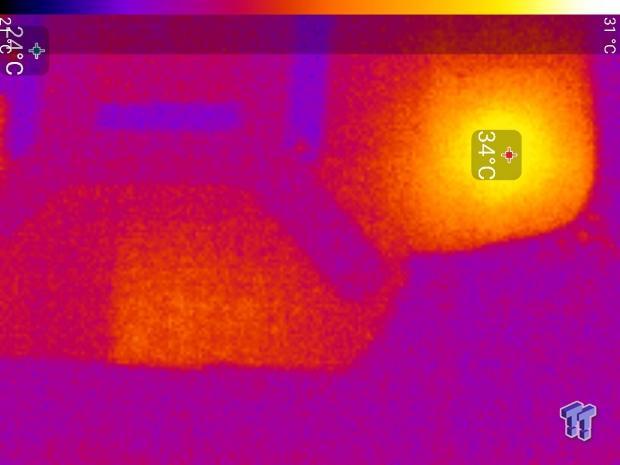

Up-close of the back of the VRM.
The VRM on the X150M-Pro ECC uses a very basic 3-phase VRM controlled by a hybrid digital controller from Intersil. The controller ensures light load efficiency is high, and we can see that only one phase is active at idle. Full load is a different story, and while temperatures are acceptable, they could be much better.
That being said, since you cannot overclock the CPU, this VRM is good enough to handle any of the E3-1200 v5 series Xeon processors or even a Core i7.
Anything under 60C is great, 60-80C is acceptable, and anything above 80C is a bit worrisome (if at stock).
What's Hot, What's Not & Final Thoughts
Here are key points about the GIGABYTE X150M-Pro ECC.
What's Hot
Features vs. Price: At under $150, the X150M-PRO ECC carries a healthy amount of features both on the rear IO and through internal headers. Without leaving a big gap in the IO where the video ports usually go, like some other C232 motherboards, GIGABYTE filled the IO panel up with USB 3.0 and USB 2.0 ports. Since this motherboard is designed for workstation and business users, legacy support is important. An LPT port, two PCI slots, and COM are all included. GIGABYTE also supplies the maximum number of SATA ports along with internal USB ports that the chipset offers.
ECC Memory Support: You should keep to GIGABYTE's qualified vendor list of memory modules and make sure that your CPU supports ECC memory. That being said, I am glad that GIGABYTE chose to include ECC support along with four memory DIMMs. I was able to load up all four DIMMs with 32GB of Kingston ECC DDR4 memory, and I didn't encounter any issues.
Intel Workstation LAN: Instead of using the consumer version, Intel i219v PHY, GIGABYTE chose the i219LM PHY to compliment the Gbit MAC in the PCH. The Intel i219LM is the workstation version of the i219v, which should offer solid performance and high reliability.
32Gb/s M.2 Slot: Many C232 motherboards don't have M.2 slots, but the X150M-PRO ECC does come with one. While there is a wide variety of M.2 slots, the one GIGABYTE has implemented here supports the latest and fastest NVMe PCI-E 3.0 x4 drives. The fast M.2 slot makes the X150M-PRO ECC very attractive for workstation users who might want to use faster consumer M.2 drives.
What's Not
Lackluster VRM: While the three-phase VRM is enough to support all the CPUs that the motherboard is capable of supporting, its high load performance isn't the best. While this won't cause any issues since it doesn't get overly hot, you will need to have adequate airflow over the VRM heat sink. Intel's reference cooler design should be enough to help cool the VRM if you run the machine 24/7.
Final Thoughts
GIGABYTE's X150M-Pro ECC is a decent C232 chipset motherboard loaded with many useful features. Motherboard layout, including internal header placement, is very good for a Micro-ATX system.
Installing a full sized GPU won't block access to any of the SATA ports, the USB 3.0 header is located in the best position for front panel USB 3.0, and the M.2 slot's location will ensure it won't overheat. The IO panel is loaded with USB ports, which are by far the most useful in business and workstation scenarios.
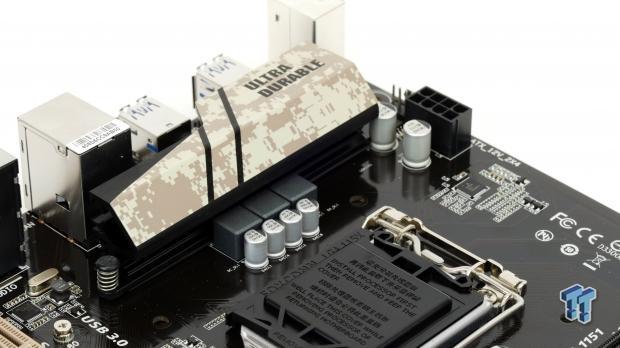
Many people complain about the lack of integrated graphics support, but that is not a motherboard specific issue. The C232 chipset doesn't support integrated graphics, and most E3-1200 v5 series Xeons don't have integrated GPUs. The main selling point of the X150M-PRO ECC over other motherboards is ECC memory support, and if you want a hassle-free experience, you need to follow GIGABYTE's recommended memory list or use the memory I used in this review.
Overall system and IO performance were solid. GIGABYTE also included four fan headers and dual BIOS technology, something other lower-tier motherboards might lack. If you are looking for a feature rich mATX workstation motherboard for an E3-1200 v5 series Xeon, the X150M-PRO ECC is worth a look.

